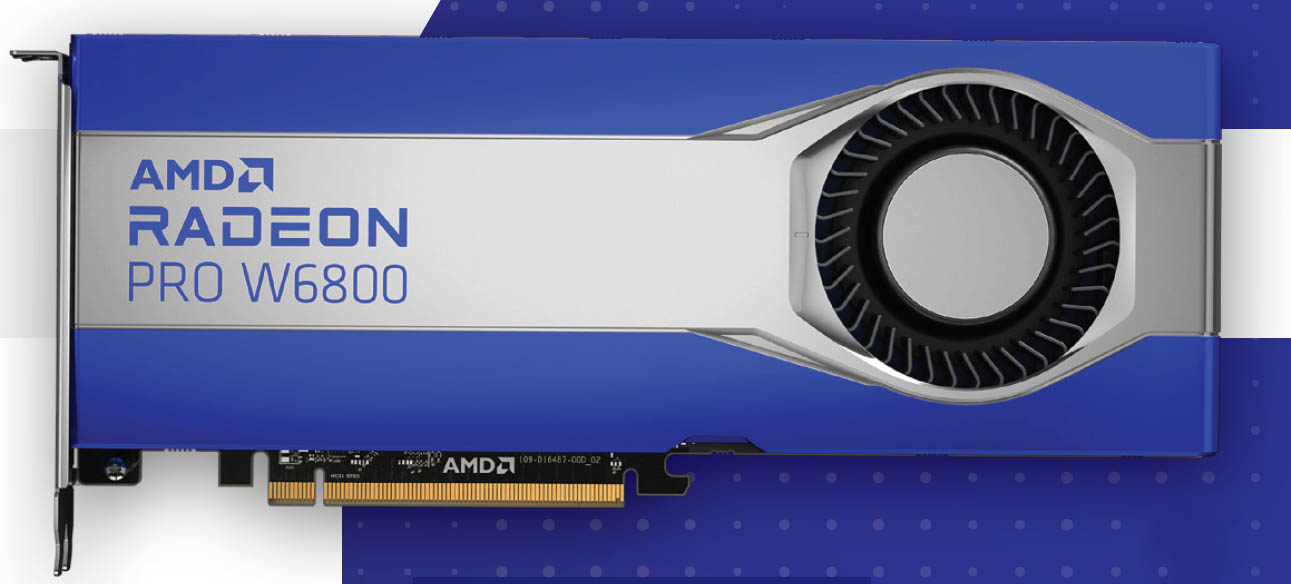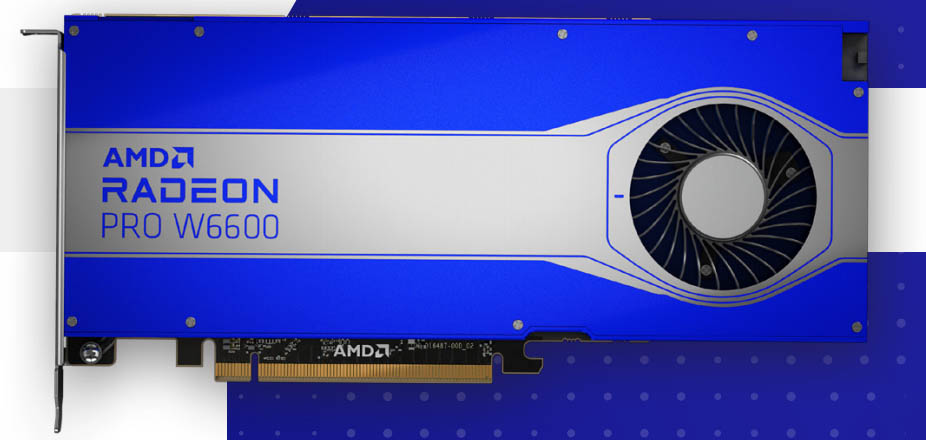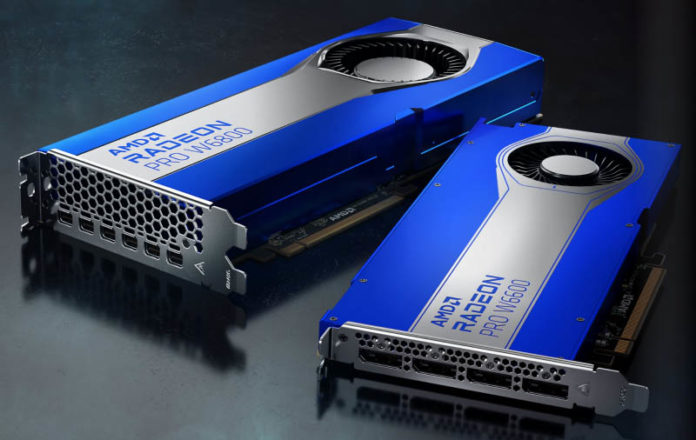AMD has two new workstation GPUs out that are designed with RDNA 2. The AMD Radeon Pro W6800 and Radeon Pro W6600 series GPUs offer AMD’s newer graphics architecture to the professional market.
AMD Radeon Pro W6800 and W6600 GPUs
The AMD Radeon Pro W6800 and W6600 are bringing the newer RDNA 2 architecture to a place beyond the gaming market and into the professional workstation market. This is a bit of an interesting announcement because the W6800 uses the larger Navi 21 die. Even though this GPU is being billed as a flagship product, it is only utilizing 60 of the 80 compute units like the Radeon RX 6800. The AMD Radeon RX 6900 XT and 6800 XT both have more compute units activated. For the professional market, we get 32GB of ECC memory and a 250W power capacity, and a dual-slot blower-style cooler.

The Radeon Pro W6600 series is based on Navi 23 which is not yet on the desktop graphics parts (although we think this is the same used in the RX 6600M for mobile.) This has 28 compute units activated, albeit on a smaller die. This is also a lower memory card with only 8GB onboard. Since there is less compute power, this has a single slot blower cooler design and up to 100W TDP.

Overall, this is a smaller lineup than NVIDIA has with Ampere, but new cards are always welcome.
Final Words
There is some hope of getting these cards. Although the pricing is around $649 for the W6600 and $2249 for the W6800, the premium they carry and the marketing direct to systems vendors may make them possible to find. Still, we are in an environment with a global chip shortage so we do not expect supply to be plentiful. On the other hand, these have higher ASPs than gaming counterparts so they may be a higher margin for AMD to sell helping supply.
You can find key specs below.
AMD Radeon Pro W6800 and W6600 Specs
Here are the key specs for the new GPUs:
| AMD Radeon Pro W6800 and W6600 Technical Specifications | ||
| W6800 | W6600 | |
| Transistor Count | 26.8 Billion (7 nm Process) | 11.06 Billion (7 nm Process) |
| Stream Processors | 3840 (60 Compute Units) | 1792 (28 Compute Units) |
| Hardware Raytracing | Yes (60 Ray Accelerators) | Yes (28 Ray Accelerators) |
| Peak FP16 Throughput (Half Precision) | 35.66 Teraflops of Compute Performance | 20.8 Teraflops of Compute Performance |
| Peak FP32 Throughput (Single Precision) | 17.83 Teraflops of Compute Performance | 10.4 Teraflops of Compute Performance |
| Infinity Cache (L3) | 128 MB Graphics Cache | 32 MB Graphics Cache |
| Dedicated Graphics Memory | 32GB of High-Performance GDDR6 | 8GB of High-Performance GDDR6 |
| Peak Memory Bandwidth | 512 GB per Second Transfer Speeds | 224 GB per Second Transfer Speeds |
| PCI Express® Support | 4.0 Ready (x16) with 3.0 Backward Compatibility | 4.0 Ready (x16) with 3.0 Backward Compatibility |
| Error Correcting Code (ECC) Support | Yes | No |
| AV1 (AOMedia Video 1) Decode Support | Yes | Yes |
| Video Acceleration4 (HEVC / H265) | Yes – Encode and Decode | Yes – Encode and Decode |
| Display Connectors | 6x Mini-DisplayPort™ 1.4 with DSC | 4x DisplayPort™ 1.4 with DSC |
| Peak Board Power | Up to 250 Watts of Power | Up to 100 Watts of Power |
| Power Connectors | 6-pin + 8-pin Power Cables | 6-pin Power Cable |
| PSU Recommendation | 650 Watts Minimum | 350 Watts Minimum |
| Board Form Factor | Full Height, Double Slot 10.5” (267mm) Length | Full Height, Single Slot 9.5” (241mm) Length |





Not having ECC on the W6600 seems…strange. Die space savings in Navi 23 to optimize for laptops?
The W6600, like its predecessors (W5500, WX7100, W7100 etc.), is primarily a visualization card (think accelerating CAD, CAE, and such programs). I don’t think these ever had ECC and full-throughput FP64 enabled. This was traditionally 800-1000$ class (or roughly 4x the price of the gaming card with the same chip), but the pricing from AMD is nowadays a bit more aggressive.
Moving up the food chain, to the visualization + compute cards, you get ECC, non-gimped FP64 and beefier chips in general. These tend to be super expensive, and I haven’t seen them that much out there in the wild.
That, and AMD has a significant trouble selling compute cards anyway, due to nVidia’s CUDA moat (a lot of legacy software requires CUDA, and developers are not keen on rewriting it).
How do individual developers write ROCm code for the MI100 accelerators without a commodity graphics card that supports FP64? If that’s not important, how will the open source ROCm become a polished and useful system without lots of independent developers using it and working on the code?
It’s a shame that the newer Radeon Pro cards have dropped support for the S400 synchronization and genlock daughtercard, and it seems that the S400 itself has been discontinued…
We will have to move our media servers to nVidia GPUs because of this.
I don’t know what’s happened to AMDs’ professional and enterprise GPU lineup, but there is definitely a lack of leadership and vision over that product group from what I can determine. Massive product gaps, feature gaps – it’s frankly unacceptable, and certainly not doing them or the end consumer any favors.
I don’t know what happened to AMDs consumer graphics business for that matter : off the top of my head I could only think of the 6880 (I think I have that wrong, as well) coming to mind for a competitive offering.
no Genlock is disappointing, too : I’m due to replace some Genlock obligatory boxes later this year, although I don’t know anything about them in detail yet, displaying broadcast video feeds in custom displays that accumulate considerable apparent cruft that’s undocumented and over time become integrated into ingrained visual response loops traders use for picking up retail sentiment drivers is definitely a important application for a good deal of volume customers. Now I’m wondering how much broadcasting related legacy code is liable to be permanently evacuated from AMD…